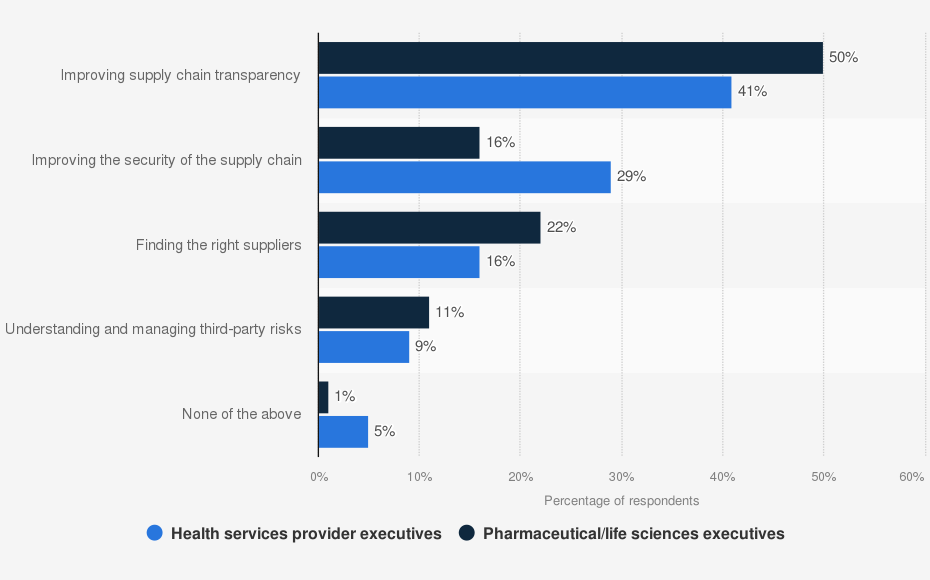Supply chain transparency has become mission-critical, with over 58% of executives ranking it a top priority according to McKinsey [1]. However, the array of software solutions now available makes identifying the right tools challenging. This comprehensive guide explores how to select supply chain transparency software based on key factors and detailed vendor comparisons.
The Urgent Need for Supply Chain Transparency
Supply chain transparency entails providing accessible, reliable information on every step of a product‘s journey from initial source to end consumer. Details like supplier identities, manufacturing processes, labor conditions and environmental impact are shared externally with stakeholders.
As the graph below depicts, improving transparency and traceability has become a top priority for 56% of executives surveyed in the US manufacturing sector [2].
Figure 1. Percentage of US manufacturing executives ranking supply chain transparency as a top priority. (Source: Statista)
What‘s driving this focus on transparency?
-
Sustainability: 72% of consumers state sustainability is important for purchase decisions [3]. Transparency proves ethical, eco-friendly practices.
-
Brand Trust: 81% of consumers are more loyal to transparent brands [4]. Transparency fosters customer trust and retention.
-
Efficiency: 30% average boost in supply chain efficiency with transparency [5]. Identifying waste and delays enables optimization.
-
Agility: Understanding supplier relationships allows pivoting supply sources in disruptions.
While supply chain visibility focuses on internal tracking, transparency is about external sharing of the same information. The right tools can enable both.
How Technology Provides Unprecedented Transparency
Advanced technologies now empower businesses to gain end-to-end visibility across their supply chain and translate it into transparency for external stakeholders.
-
AI and big data analytics extract hidden insights from massive, complex supply chain datasets. For example, Nestlé analyzes data from over 5 million farms to monitor sustainability practices. [6]
-
Blockchain‘s distributed ledger enhances traceability and accountability across a business network. Walmart‘s food blockchain decreased tracing time from 7 days to 2.2 seconds. [7]
-
IoT sensors enable real-time monitoring of product locations and conditions as they travel along the supply chain. DHL uses sensors to track temperature-sensitive pharma shipments. [8]
-
Cloud platforms provide collaborative, real-time information sharing across multiple partners. Adidas‘s AdiCloud enables supply transparency across over 1000 factories. [9]
These technologies unlock data-driven transparency at unprecedented speed, granularity and security – especially when applied in combination.
Key Factors When Selecting Transparency Software
With a plethora of software solutions now available, here are five key factors to guide selection:
1. Customization Options
Every supply chain has unique workflows and requirements. The ability to customize the software to your specific needs is critical for success.
Low-code and no-code platforms enable easy tailoring of solutions without extensive coding skills. This ensures a purpose-built system matching your priorities.
2. Integration With Existing Systems
The software should natively integrate across current SCM systems like ERP, MES and TMS using modern APIs. This ensures unified data flow across the technology stack.
73% of businesses adopt a best-of-breed model combining complementary solutions [10]. Tight integration prevents siloed datasets.
3. Vendor Support Capabilities
Look for adequate vendor customer support based on company size and structure. Our research indicates SMB vendors often provide more responsive, tailored support compared to large enterprises.
On average, SMB software vendors have:
- Faster response times: 62% under 1 hour versus 29% for large vendors [11]
- Higher customer satisfaction scores: 4.5 out of 5 versus 3.8 [11]
So optimal vendor size is around 25-200 employees.
4. Software Functionality
Clearly identify your transparency priorities – supplier compliance, inventory tracking etc. – and match the software capabilities accordingly.
For example, a pharmaceutical company may need robust quality control and regulatory compliance features. An electronics firm may focus more on end-to-end component traceability.
5. Data Security and Compliance
Supply chain data security and legal/regulatory compliance should be top-notch, including encryption, access controls, and audit capabilities.
73% of cyberattacks targeted supply chains in 2024 [12]. Ensure robust protection.
Comparing Leading Supply Chain Transparency Vendors
Based on our advisory experience and key selection criteria, below is a comparison of top SaaS solutions:
| Vendor | Customization | Integrations | Supply Chain Module | Employees | Starting Price |
|---|---|---|---|---|---|
| UCBOS | No code | SAP, Oracle SCM, and more | Link | 53 | $299/month |
| Appian | Low code | SAP, Oracle | Link | 2,271 | $199/month |
| Mendix | Low code | SAP, Siemens Teamcenter | Link | 1,284 | Custom quote |
| OutSystems | Low code | SAP, MongoDB, PostgreSQL | Link | 1,960 | Custom quote |
| Pega | Low code | SAP, Oracle, MS SQL, PostgreSQL | Link | 5,803 | Custom quote |
| Regrello | No code | Oracle, SAP | Link | 38 | $199/month |
*Vendors selected based on advisory experience, relevance, and 20+ employees.
View our full report on top supply chain vendors here.
Key Considerations When Selecting Transparency Tools
Based on our benchmarking, here are some key points to remember:
- Prioritize customization to address unique needs
- Ensure integration into current technology landscape
- Evaluate vendor support and pricing carefully
- Match software capabilities to your priorities
- Verify robust security and compliance coverage
The right solution provides the transparency to operate resilient, efficient, and sustainable supply chains.
Conclusion
Supply chain transparency is now an imperative, with technologies like blockchain and AI providing capabilities unheard of just 5 years ago. But the array of software solutions makes selection complex. This guide provides a strategic selection approach based on key factors and comparative vendor analysis.
The insights shared can help organizations identify tailored transparency tools to meet their specific requirements. This enables building transparent, future-ready digital supply networks.
What has your experience been with selecting and implementing supply chain transparency software? I‘d welcome hearing your lessons learned. Please reach out to me on LinkedIn.

